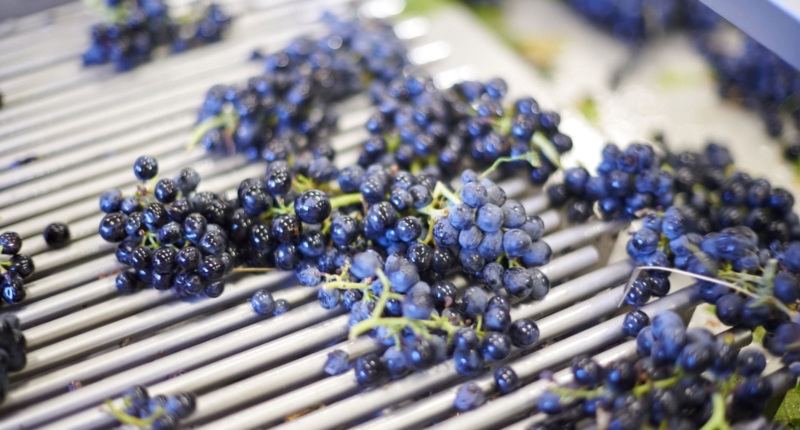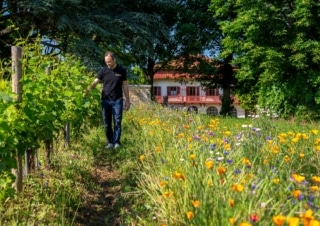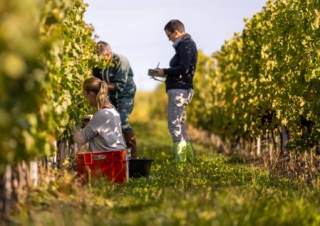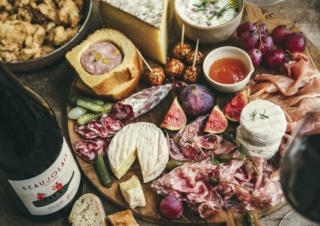Transforming grapes into wine is a science as much as an art. It is a complex process that requires expert knowledge. Each vineyard perfects its technique and, even though the procedures can often be similar, there are many different ways of doing things.
Winegrowers in the Beaujolais region can choose between several vinification methods including a method known as known as Beaujolais vinification.
First stage: the harvests
It all starts with the harvest. The bunches of Gamay noir à jus blanc grapes are handpicked with great care. Damaged berries are removed during the picking.
Why is so much care taken, given that the grapes are going to be pressed?
That’s the part of the process that’s specific to the Beaujolais region: the grapes are put into vats, without compacting, in entire bunches and are not removed from the stalk. This process gives the wine many of its fruity aromas.
Second stage: semi-carbonic maceration
This is where it gets complicated! The following explains the different processes at work.
The grapes macerate in the vat. The whole bunches of grapes in the top of the tank are in an atmosphere where carbonic gas progressively replaces the oxygen from the air. Fermentation inside the berries begins. This is known as intracellular fermentation. It produces small quantities of alcohol and releases specific aromas.
The bunches in the middle of the vat macerate in the juice resulting from the accumulation of grapes. The grape skin determines what happens to the bunches of grapes. The skin releases tannins, coloured pigments and aromatic compounds. Tannins determine the future structure of the wines on the palate, the pigments and the colour of the wine. It’s during this stage that the wine takes on its red robe. Yeasts act on the juice from the grape pulp, transforming the sugar into alcohol.
At the bottom of the vat, the compressed grapes release juice. The yeasts, microorganisms that are naturally present on the grapes, then go into action. They wake up when they come into contact with the sugars in the grape juice, transforming them into alcohol and carbonic gas. This is known as alcoholic fermentation.
“Pouring juice over the grape cap”
Alongside this natural process, the winemaker regularly pours juice over the bunches of grapes on the surface, known as the ‘cap’, to ensure a consistent temperature. The juice used for pouring is taken from the bottom of the vat. This is called pumping over or remontage. Soaking the grape in its own juice results in an even fruitier wine.
Everything we have just described is called semi-carbonic maceration. It is a term specific to the Beaujolais region.
How is this different to “traditional” carbonic maceration?
In the Beaujolais region, the vat is not hermetically sealed once it is filled. The winemakers allow fermentation to occur naturally without adding carbonic gas.
How long does maceration take?
Maceration influences the cellaring potential of wine. It varies from 4 to 15 days on average, depending on the wine that a winemaker wants to obtain.
In the ten Beaujolais AOC crus, the bunches of grapes are left to macerate for around 10 to 15 days, for Beaujolais and Beaujolais Villages it’s around 6 to 10 days.
For primeur wines (Beaujolais Nouveau and Beaujolais Villages Nouveau), the process takes 4 to 6 days.
Third stage: devatting
After maceration comes the soutirage or racking: the free-run juice is drained off from the bottom of the vat.
The bunches of grapes that remain in the vat are removed to be pressed: this is known as devatting and pressing.
Pressing the grapes leads to paradise! Or rather “paradis” as the press juice is called in French, a very sweet and aromatic nectar.
The free-run juice and the press juice are then blended to continue their fermentation. This blend makes the vintage richer and the aromas more complex.
This is where the élevage or maturing starts. It’s during this phase that the wine reveals its potential.






